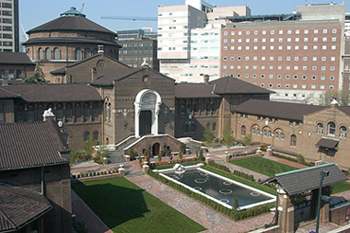
In the course of their graduate career at Penn, AAMW students have the unusual opportunity to work with a collection of Mediterranean art and artifacts larger than that at any other university in North America. Founded in 1887, the University of Pennsylvania Museum of Archaeology and Anthropology has conducted more than 400 archaeological and anthropological expeditions around the world. Three gallery floors feature materials from Egypt, Mesopotamia, the Levant, Mesoamerica, Asia and the ancient Mediterranean World, as well as artifacts from native peoples of the Americas, Africa and Polynesia. The Museum also serves as the headquarters of the American Research Institute in Turkey, which maintains branches in Istanbul and Ankara.
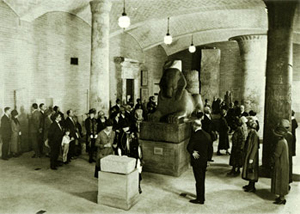
One of the most distinctive features of the Museum is its commitment to ethics in archaeology as well as to the archaeological context of the objects in its collection. From the beginning of its history, the University Museum articulated a collections policy less interested in individual objects and more with legally acquiring whole groups of objects that had come from scientific exploration, and that would be accompanied by carefully and scientifically gathered documentation. The Museum was the first such institution in North America to endorse the UNESCO Convention on the Means of Prohibiting and Preventing the Illicit Import, Export, and Transfer of Ownership of Cultural Property.
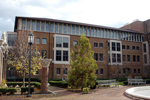
In the late 19th and early 20th century, North American Museums regularly sponsored excavations in the Mediterranean and shared ownership of the discoveries with the host country. Much of the Museum's collection derives from such reciprocal arrangements. The new Etruscan exhibition, with its complete and well-documented tomb groups from cemeteries at Narce and Vulci, is a perfect example of the Museum's mission, as are the Roman exhibits dealing with Minturnae and Nemi.
The Mediterranean Section
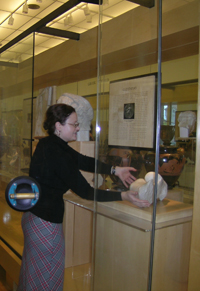
The Mediterranean Section collections comprise approximately 30,000 objects of Greek, Etruscan, Roman, Cypriot, and Bronze Age Aegean origin, the majority of which were acquired before World War I, when the laws governing the export of antiquities made it possible.
The recently renovated ancient Greek gallery features more than 400 artifacts, dating from the late Bronze Age through the late Hellenistic period. Spectacular examples of ancient Greek vases, sculpture, coins, and bronzes are featured in the exhibition, which includes fragments of a colossal cult statue from the Museum's excavations at Beth Shean. The material from the Bronze Age site of Vrokastro in Crete, excavated by the Museum between 1910 and 1912, was acquired by a permit from the Greek government at the time of excavation. A similar arrangement was concluded with the Cyprus Antiquities Department with regard to the Museum's excavations at Kourion, which yielded a large assemblage of material, especially from the Sanctuary of Apollo Hylates.
The new Etruscan gallery showcases the Museum's extraordinary Etruscan and Italic collection, one of the finest in the North America. Comprehensive in scope, the collection is composed of some 3500 objects from the entire span of the Etruscan civilization, from the 8th century to the 2nd century B.C. Most of the objects are from known contexts, including an important collection from a group of tombs at Vulci, Chiusi, Tuscania, and Narce. An impressive series of architectural terracottas from Cerveteri and Orvieto documents the development of Etruscan temple architecture, and there are also exceptional examples of Etruscan bucchero, inscriptions, and gold jewelry.
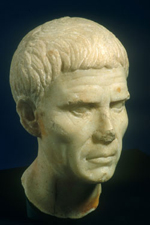
The Roman collection includes material excavated in the Sanctuary of Diana on the shores of Lake Nemi, south of Rome, such as Republican-period votive statuettes and marble vessels. One of the most important assemblages comes from the site of Minturnae on the west coast of Italy, between Rome and Naples. Minturnae was excavated by the University of Pennsylvania from 1931-1933, at the conclusion of which the Museum received from Italy a generous division of the finds, including eight marble sculptures, pottery, lamps, and important Italo-Etruscan architectural terracottas. The monumental marble block from Puteoli, the centerpiece of the exhibition, contains a defaced inscription of Domitian on one side, and a relief of Trajan's Praetorian guard, probably from an honorific monument, on the other.
The Egyptian Section's excavations at Memphis from 1915 to 1923, and at Meydum between 1929 and 1932 provided large numbers of Roman coins, including a Late Roman coin hoard of around 2,300 specimens. There are also nearly 600 ancient gems (the Sommerville collection), and an exceptionally large collection of Roman glass, some of which was excavated by the Museum in the cemeteries of Beth Shean.
The Near Eastern Section oversees a large and recently renovated gallery devoted to Canaan and Ancient Israel, which is the first major North American exhibition dedicated to the archaeology of ancient Israel and neighboring lands. It features hundreds of rare artifacts from about 3000 to 586 B.C., including art and artifacts from the University of Pennsylvania's excavations in Israel (Beth Shean, Gibeon, Beth-shemesh) and Lebanon (Sarepta).
